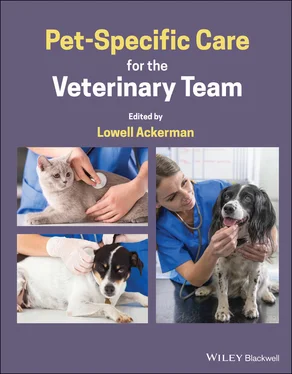A simple autosomal recessive disorder for which no carrier test exists allows the propagation and dissemination of inapparent carriers in the gene pool. Carrier risk must be determined based on the knowledge of affected or carrier relatives. These can be visualized through vertical pedigrees on the OFA website, or other health databases (see 3.7Genetic Health Registries and Research Organizations). Quality carriers should be replaced with nonaffected relatives and bred to individuals with low carrier risk. This can be assessed through examination of parents and grandparents (depth of pedigree normalcy), siblings and siblings to the parents (breadth of pedigree normalcy). High carrier‐risk individuals should only be bred to low‐risk individuals. The high‐risk parent should be replaced for breeding with a lower risk quality offspring. To further limit the spread of the defective gene, the offspring should be used in only a limited number of carefully planned matings, and then should also be replaced with one or two quality offspring. The rest of the litter should be placed in nonbreeding (pet) homes. With this mating scheme, the breeder is maintaining the good genes of the line, reducing the carrier risk with each generation, and replacing, not adding to the overall carrier risk in the breeding population.
Autosomal dominant genetic disorders are usually easy to manage. As affected individuals produce approximately 50% affected offspring, they should be replaced for breeding with normal relatives. Issues with some autosomal dominant disorders include incomplete penetrance. With these disorders, the presence of the defective gene still confers risk of producing affected offspring and should be selected against.
For sex‐linked (also known as X‐linked) recessive defective genes, selecting a normal male for breeding loses the defective gene in one generation. High carrier‐risk females should not be used, as carrier females produce 50% affected sons. Rare sex‐linked dominant disorders are managed the same way as autosomal dominant disorders.
Most complex/polygenic disorders and those with an undetermined mode of inheritance have no tests for carriers, but they do have phenotypic tests that can identify affected individuals. Controlling complexly inherited disorders involves (i) identifying traits for selection that more closely represent the expression of disease‐causing genes, (ii) the standardization of nuisance factors (such as environment) that can limit selective pressure against the genes, and (iii) selecting for breadth as well as depth of pedigree normalcy as demonstrated by vertical pedigrees.
With polygenic disorders, a number of liability genes must combine to cross a threshold and produce an affected individual. A clinically normal individual from a litter that had one or no individuals affected with a complexly inherited disorder is expected to carry a lower amount of liability genes than an individual with a greater number of affected littermates. This is why it is important to screen both pet and breeding dogs and cats for complexly inherited disorders. Information on the siblings of the parents of potential breeding individuals provides additional data on which to base breeding decisions. The patient's own results represent its phenotype, but the relative's results are more representative of the patient's genotype.
If an individual is diagnosed with a genetic disorder, it can be replaced with a normal sibling or parent and bred to a mate whose risk of having liability genes is low. Replace the higher‐risk parent with a lower‐risk offspring that equals or exceeds it in other aspects, and repeat the process.
Genetic testing companies are increasingly providing genetic diversity measurements to breeders for individual dogs or cats and their proposed matings. As discussed in the chapter on genetic testing (see 3.6), all breeds by definition have high homozygosity which allows them to breed true. Homozygosity does not cause genetic disease. It is the presence of disease‐causing mutations that cause disease, and genetic counseling recommendations should be specifically directed against specific diseases. Genetic diversity has to do with maintaining unique breeding lines in a breed. It is the genetic differences between individuals in a breed that provide breed genetic diversity, not within‐individual homozygosity. It is only in rare instances when a breed suffers from high‐frequency genetic disease or genetic‐based infertility that a breed‐rescue type of genetic diversity breeding scheme may be indicated.
Genetic tests are extremely useful tools to help manage genetic disorders. Even when there is no test or an unknown mode of inheritance, much can still be done to reduce the incidence of affected and carrier animals (see 3.4Predicting and Eliminating Disease Traits). The use of these guidelines can assist clients in making objective breeding decisions for genetic disease management while continuing their breeding lines.
It is distressing when a genetic disorder is confirmed in an animal. The veterinary team can make positive and practical genetic counseling recommendations to maintain breed lines and genetic diversity, and improve the overall health of breeds. Each breeder will have their own rate of progress depending on the frequency of the defective gene(s) in their own breeding animals, and which desirable individuals carry liability genes.
With the increasing availability of genetic tests, there is increased risk of misusing and misinterpreting them. There is also the propensity to recommend inappropriate and unnecessary genetic testing, which can diminish client compliance. It is our responsibility to understand the proper use and interpretation of genetic tests, and to provide appropriate genetic counseling recommendations to our clients.
 EXAMPLES
EXAMPLES
Example 1
A client is interested in acquiring an Alaskan malamute. You or your team discuss the grooming (and shedding) expected in the breed, as well as its exercise requirements. You look up and print out the OFA‐CHIC prebreeding recommendations for the client which includes a hip evaluation for hip dysplasia, ophthalmologist eye examination, and a genetic test for polyneuropathy – a breed‐specific genetic disorder. You counsel the client to ask anyone offering Alaskan malamute puppies for official documentation of the above genetic testing on both parents of the puppies. The OFA‐CHIC also lists recommended testing for hypothyroidism and a cardiac evaluation, indicating that these diseases are also present in the breed. The client should inquire if either of the parents have any health issues, including common genetic disorders such as allergies, cruciate ligament rupture or significant arthritis.
You remove bladder stones from a feline patient and submit them for analysis. They come back as calcium oxalate stones. You must counsel the client that this is a genetic predisposition and the cat is at high risk of forming more stones. You offer medical recommendations to minimize the risk of future stone formation. The owner desires to breed the cat. You inform the owner that there is no genetic test for oxalate urolithiasis liability. Due to the severity of the disease, affected cats should not be used for breeding.
A French bulldog owner presents their older dog for evaluation due to clinical signs of spinal cord disease. The owner has a commercial genetic test result showing the dog is homozygous “at risk” for the sod1 liability gene for DM. You tell the owner that no French bulldogs have been pathologically confirmed with DM and the genetic test is likely not predictive for their breed. You further inform the owner that French bulldogs have a high incidence of intervertebral disc disease, which is a treatable condition (versus the fatal prognosis of DM). Further work‐up reveals spinal cord compression which is successfully treated surgically.
Читать дальше

 EXAMPLES
EXAMPLES










